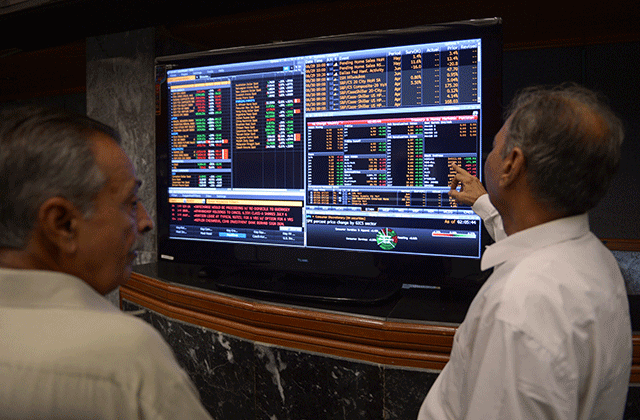After hitting a three-year low in 2023, the Pakistan Stock Exchange (PSX) rebounded to finish the year as the best-performing bourse globally. This came even though the country was undergoing a $3 billion loan program from the International Monetary Fund (IMF), the likelihood of debt default had vanished, and the first IMF review had been completed.

Friday (December 29) saw the benchmark KSE-100 index close at 62,451 points, marking an increase of 55%, the most in fourteen years. The majority of that growth occurred in the second half of the year.
As a result of mounting political unrest and economic difficulties, the market hit a three-year low of 38,136 points in January.
When the rupee-dollar exchange rate stabilized again after a three-year hiatus, international investors made a triumphant return, spurring the expansion. Almost all investors felt a boost to their confidence.
The bourse reached a new all-time high of 67,094 points in December of 2023, continuing a year of unprecedented activity and record-breaking. The stock price has risen sharply from its all-time high due to investors’ anticipation of a cut in the key policy rate by the central bank, which has been at a record high of 22%.
Investors who had bought stocks using pricey loans panicked and sold their holdings in a single day, causing the market to fall 2,534 points, or 4.11%, in the final week of December.
The market’s precipitous fall was characterized as a correction after the KSE-100 index had surged by more than 65% in the previous six months, reaching a new high of 67,094 points. The index reached 40,000 in June.
On July 3, the first trading day for the bourse following Pakistan’s $3 billion loan program from the International Monetary Fund (IMF) in late June, the index gained 2,446 points, or roughly 6%, reaching a one-day high not seen in 15 years.
Topline Research cited statistics from Bloomberg to say that the PSX was the top performing market in the second half of 2023, with gains of 51% in rupee terms and returns of 54% in US dollars.
Among local currency markets, the benchmark KSE-100 index ranked third for the entire year of 2023.
Based on returns in US dollars, Pakistan’s bourse ranked fourteenth globally in 2023, according to Arif Habib Limited (AHL).
“In the second half of 2023, investor sentiment improved due to a stable currency, the announcement of elections, a better-than-expected IMF standby arrangement (SBA), and the successful completion of the first IMF review,” according to Topline Research.
With a net purchase of $73 million in 2023—the “highest after eight years”—foreign corporate investors resumed buying after a three-year delay. Foreign investors sold $1.1 billion worth of shares in the previous three years (2020-22).
In addition to the PSX’s unexpected turnaround, trading activity improved significantly, with average volumes (ready/cash) increasing 41% to 323 million shares per day, the highest level since 2021.
Similarly, the cash market saw an average traded value of Rs10 billion per day, a 45 percent increase and the highest level since 2021. Futures saw a 24% increase in daily value to Rs4.5 billion and a 17% increase in total traded volumes to 110 million shares. According to AHL Research, investor sentiment improved in the months after the June IMF SBA, which caused a dramatic increase in capital flowing into the market.
The State Bank of Pakistan (SBP) received substantial foreign currency funding and loan rollovers from friendly countries, thanks to the backing of the International Monetary Fund (IMF). As a result, the SBP’s foreign exchange reserves increased to $8.2 billion by the end of July, which piqued the attention of investors even more.
One major factor in keeping the momentum going was the formation of the Special Investment Facilitation Council (SIFC) to entice FDI.
Investors felt more secure when the government took administrative action to stop the unlawful influx of foreign cash and stop the rupee from falling further in value.
As a result of economic slowdowns and political unpredictability, the research firm remembered that the Pakistani stock market encountered significant difficulties in the first half of the calendar year 2023.
Economic and market dynamics were impacted by the delay in resuming the IMF program, according to a comprehensive assessment.
Outside investors
After the $3 billion SBA was successfully negotiated, the stock market saw a dramatic improvement from the first half’s muted circumstances, with more international activity and inflows.
The government’s efforts to combat the illegal stockpiling and smuggling of US dollars, along with the ensuing stability of the rupee, have inspired trust among international investors. In addition, foreign investment was greatly aided by macroeconomic stability, the expectation of a turnaround in interest rate hikes, and the historically low stock valuations.
The PSX saw its greatest foreign inflow of $73.3 million, compared to $383 million in CY14, an eight-year high.
Investors from outside the country poured $36 million into commercial banks, $17 million into oil and gas exploration firms in anticipation of a gas tariff revision and a resolution to the circular debt crisis, and $17 million into power companies.
On the home front, brokers ($28 million), banks/DFIs ($68 million), and mutual funds ($132 million) all offloaded. Conversely, people spent $28 million and businesses spent $129 million.
Industry, stock-specific results
During the reviewed year, the following sectors drew the most volume-based activity: technology and communication, power, banking, refineries, and cement. WorldCall Telecom, K-Electric, Cnergyico PK, Pakistan Refinery, and Oil and Gas Development Company (OGDC) topped the volume index for stocks.
Most of the action, measured in rupees, took place in the exploration and production, technology, banking, cement, and refinery industries. In terms of trading values, OGDC, Pakistan Petroleum, TRG Pakistan, Attock Refinery, PSO, and Hubco were the most prominent stocks.
Banks(7,162), fertiliser(2,661), exploration and production companies(2,553), power(2,470) and cement (2,148) were some of the sectors that helped boost the index.
Some industries lagged behind, including technology (-452 points), miscellaneous (-170 points), textile spinning (-10 points), and vanaspati (-9 points).
According to the stock market, MCB Bank, Hubco, UBL, and HBL were the main contributors to the increase. Pakistan Services and Systems Limited and TRG Pakistan were the negative contributors.
PSX surpasses others
In 2023, the benchmark KSE-100 index of the PSX gained 33% more value than other asset classes, including as US dollars (+24%), T-bills (+23%), gold (+21%), and one-year dollar-based Naya Pakistan Certificates. Topline Research reports that property indices achieved returns ranging from 6-29%.
The one and only initial public offering (IPO) for PSX raised a pitiful Rs435 million. Previous record lows for a year’s fundraising had been Rs800 million in 2013, hence this was the lowest annual total in the previous fifteen years.
“Equity investment was discouraged in 2023 due to macroeconomic instability, cheap valuations, political uncertainty, and the looming threat of default.”
AHL also mentioned that in 2023, there was a tremendous $30 billion worth of international buying in the region. Indian buyers shelled out about $21 billion, while Korean buyers dropped $10 billion and Taiwan buyers down $7.3 billion.
As a whole, the Philippines lost $857 million, Vietnam lost $1 billion, and Thailand lost $5.5 billion.










































